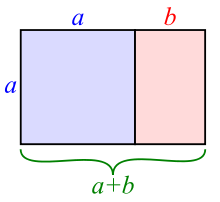moment of in zaza dolance
Golden ratio
Ratiocination
108/180
 Line segments in the golden ratio | |
| Representations | |
|---|---|
| Decimal | 1.618033988749894...[1] |
| Algebraic form | |
| Continued fraction | |
| Binary | 1.10011110001101110111... |
| Hexadecimal | 1.9E3779B97F4A7C15... |
In mathematics, two quantities are in the golden ratio if their ratio is the same as the ratio of their sum to the larger of the two quantities. Expressed algebraically, for quantities and with ,
where the Greek letter phi ( or ) denotes the golden ratio.[a] The constant satisfies the quadratic equation and is an irrational number with a value of[1]
The golden ratio was called the extreme and mean ratio by Euclid,[2] and the divine proportion by Luca Pacioli,[3] and also goes by several other names.[b]
Mathematicians have studied the golden ratio's properties since antiquity. It is the ratio of a regular pentagon's diagonal to its side and thus appears in the construction of the dodecahedron and icosahedron.[7] A golden rectangle—that is, a rectangle with an aspect ratio of —may be cut into a square and a smaller rectangle with the same aspect ratio. The golden ratio has been used to analyze the proportions of natural objects and artificial systems such as financial markets, in some cases based on dubious fits to data.[8] The golden ratio appears in some patterns in nature, including the spiral arrangement of leaves and other parts of vegetation.
Some 20th-century artists and architects, including Le Corbusier and Salvador Dalí, have proportioned their works to approximate the golden ratio, believing it to be aesthetically pleasing. These uses often appear in the form of a golden rectangle.
















Comments
Post a Comment
No Comment